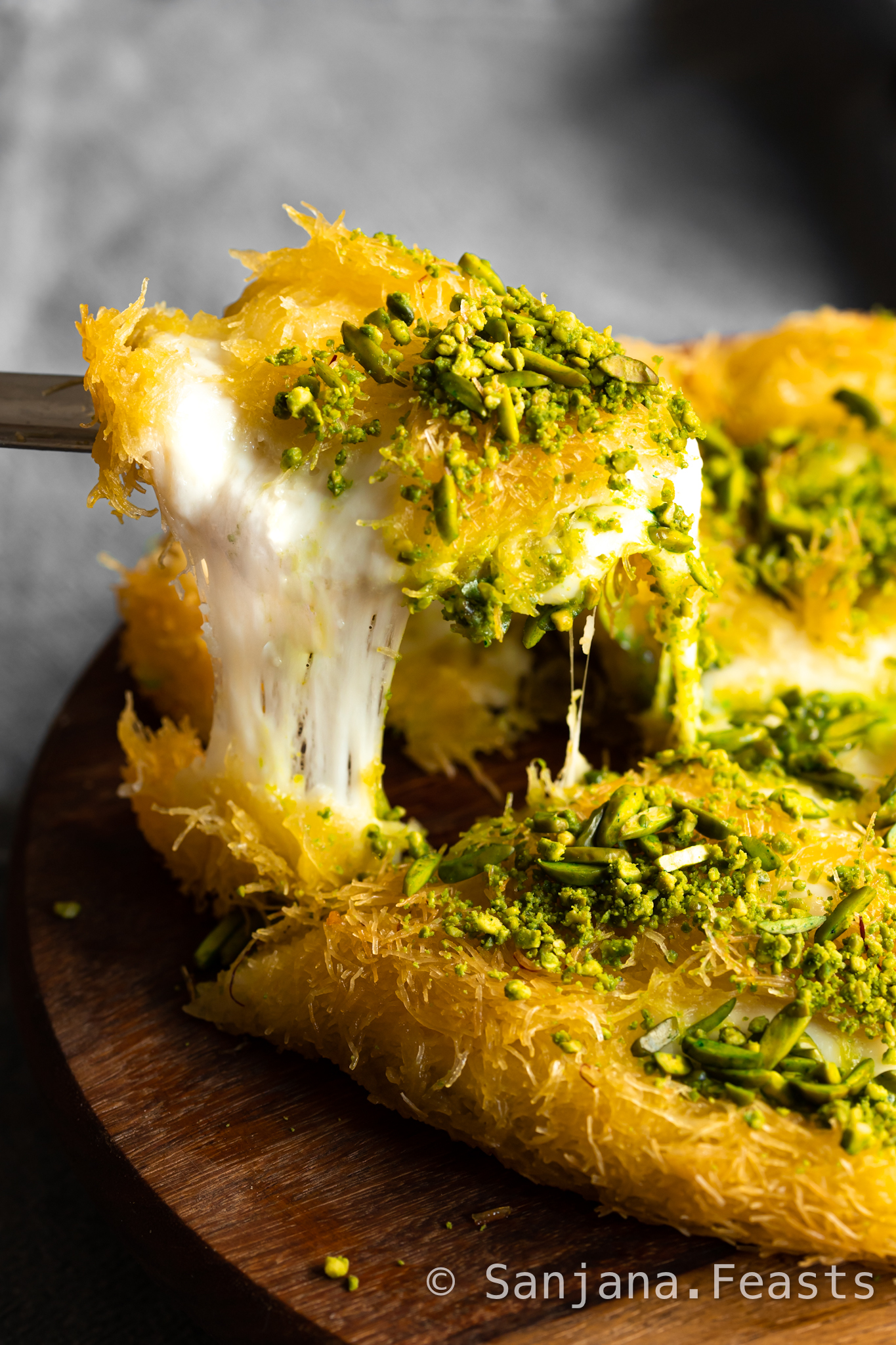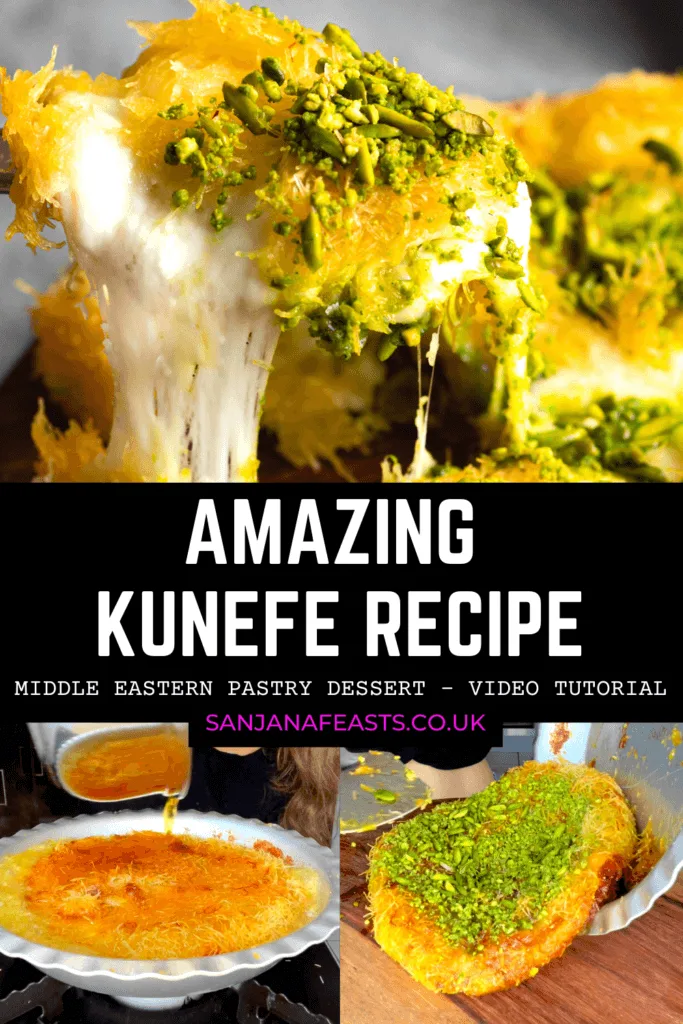Learn how to make this Easy Künefe recipe | Delicious Knafeh or Kunafa, a popular Middle-Eastern dessert made with shredded filo pastry, gooey, melted cheese and finally, drizzled with a fragrant syrup.
Pistachios are the most traditional garnish and for me, the more pistachios there are, the better. It’s crispy, cheesy, sweet and so decadent with a cup of strong coffee.
This recipe for Künefe is…
- Simple
- Great for a crowd
- Uses minimal ingredients
- A perfect Middle Eastern dessert
What is Künefe?
Künefe is a supremely decadent dessert is a pastry dish that’s traditionally stuffed with cheese or ashta (cream). If you love Middle Eastern food, you may have been lucky enough to try it in a restaurant. Well, let me tell you how easy it is to make this impressive-looking pud at home, in no time at all!
Where does Künefe come from?
Sometimes called Kunafa or Knafeh, Künefe is popular across middle eastern and Arabic countries. The name changes depending on where it is being prepared, but you can be sure that the final dessert is always going to be a memorable one.
One of the most well-known preparations of the dessert is Knafeh Nabulsiyeh, which originated in the city of Nablus (Palestine). This version calls for a semolina-based dough (coloured with orange food colour) and white, brined Nabulsi cheese, also from the region.
What kind of pastry is used for Künefe?
Kunafa is made from Kataifi which looks a lot like shredded phyllo dough. You can buy it in the chilled or frozen section of most Middle Eastern supermarkets. This is one of the most popular pastries to use in Turkish desserts, and many Arabic ones too.
This kataifi is first torn, coated in butter and then spread onto a pan and stuffed with either cheese or ashta (thickened cream). Cook Künefe over a very low heat and then drizzle with simple syrup and garnish with as many pistachios as you like.
What kind of cheese is used for Künefe?
In most cases, Akkawi (white) cheese is the most popular stuffing for this dish, but since this not so easily available in shops here, you can substitute it for mozzarella. I like to use low-moisture mozzarella such as the kind used for topping pizza.
Not only does this melt beautifully for a super stretchy cheese pull, it also will prevent the Künefe from turning soggy. This can happen with mozzarella packed in whey. If you can only find mozzarella in whey, simply drain it well before using.
I have also had success making Künefe with Turkish Cecil Cheese (Tel Peynir). It has a lovely stringy texture and slightly sharper flavour than traditional mozzarella.
How to make vegan Künefe
It might seem impossible, but veganising a recipe like Künefe isn’t as difficult as you might think. All you need to do is switch out the butter for coconut oil. Note that your favourite dairy-free spread may not work so well, since it contains high percentage of hydrogenated fat (water).
Then simply use a dairy-free mozzarella alternative for the cheese element. I recommend one with a good stretch factor, such as this vegan mozzarella recipe by School Night Vegan.
How to make Künefe in 5 easy steps!
1. Prepare the pan
Generously butter a 20cm (8-inch) aluminium pie pan or traditional Künefe plate. You can colour the butter with some yellow or orange food colour if you like, but this is optional.
Note: Professionals will typically use a traditional Künefe plate (aluminium) but this isn’t totally necessary. You can just as easily use an aluminium pie plate (these tend to be deeper which is actually ideal for cramming more cheese into the filling!). Just make sure your tin is suitable for using on the stovetop.
2. Prepare the kadayif (kataifi/pastry)
Place the kadayif in a large bowl or basin. Tear it into small shreds using your hands. Pour over the melted butter and mix well to coat all the pastry. Scatter half of the kadayif into the prepared pan and press firmly with your hands. I like to cover some of the sides of the pan at this point, which helps in preventing the cheese from escaping at the sides during cooking.
3. Add the cheese
Place the shredded or sliced cheese in the centre of the pastry and cover with the remainder of the kadayif. Press to even out.Cook the Künefe over a very low heat, moving the pan every 10 seconds or so to ensure the burner underneath is cooking it evenly all over the base. Use a spatula to carefully ensure it is not sticking to the pan. Loosen it as much as you can during the cooking process to prevent sticking.
4. Flip!
Once the base is golden brown, place a plate on top of the Künefe and use oven gloves to flip the pan upside down to release it. Butter the dish again. Slide the Künefe back into the hot pan and cook the other side in the same way as the first. Once the second side has browned, keep the Künefe aside while you make the syrup.
5. Add the sweet sugar syrup
To make the sugar syrup, place the sugar, water, rosewater and saffron in a small saucepan. Bring to the boil and simmer for 3-4 minutes until all the sugar has dissolved and it has thickened very slightly. Carefully pour the hot sugar syrup over the warm Künefe and allow it to stand for 5-10 minutes before slicing and serving.
More desserts you might like
- Chocolate Samosa recipe
- Gulab Jamun Cake
- Gajar ka Halwa (Carrot Halwa Recipe)
- Zarda Rice (Sweet Yellow Rice)
Künefe in the oven?
If you don’t fancy cooking this on the stovetop, you can bake Künefe in a pre-heated oven 180°C fan/350°F/gas mark 4 for 30 minutes, turning the pastry halfway through the cooking time.
Easy Künefe Recipe | Delicious Knafeh or Kunafa recipe card
Easy Künefe Recipe | Delicious Knafeh or Kunafa

Learn how to make Künefe! A popular Middle-Eastern dessert made with shredded filo pastry, gooey, melted cheese and a fragrant syrup. It's crispy, cheesy, sweet and so decadent with a cup of strong coffee.
Ingredients
- 200g kadayif (kataifi), thawed if frozen
- 125g unsalted butter (melted), plus 65g more for greasing the tin
- 200g low-moisture mozzarella, shredded or sliced
- 150g sugar
- 175g water
- 1/2 tsp rose extract or 2 tsp rosewater
- Generous pinch of saffron
Instructions
- Generously butter a 20cm (8-inch) aluminium pie pan or traditional Künefe plate. You can colour the butter with some yellow or orange food colour if you like, but this is optional.
- Place the kadayif in a large bowl or basin. Tear it into small shreds using your hands. Pour over the melted butter and mix well to coat all the pastry.
- Scatter half of the kadayif into the prepared pan and press firmly with your hands. I like to cover some of the sides of the pan at this point, which helps in preventing the cheese from escaping at the sides during cooking.
- Place the shredded or sliced cheese in the centre of the pastry and cover with the remainder of the kadayif. Press to even out.
- Cook the Künefe over a very low heat, moving the pan every 10 seconds or so to ensure the burner underneath is cooking it evenly all over the base. Use a spatula to carefully ensure it is not sticking to the pan. Loosen it as much as you can during the cooking process to prevent sticking.
- Once the base is golden brown, place a plate on top of the Künefe and use oven gloves to flip the pan upside down to release it. Butter the dish again. Slide the Künefe back into the hot pan and cook the other side in the same way as the first. Once the second side has browned, keep the Künefe aside while you make the syrup.
- To make the sugar syrup, place the sugar, water, rosewater and saffron in a small saucepan. Bring to the boil and simmer for 3-4 minutes until all the sugar has dissolved and it has thickened very slightly.
- Carefully pour the hot sugar syrup over the warm Künefe and allow it to stand for 5-10 minutes before slicing and serving.
Notes
To make Künefe ahead of time
- Assemble the Künefe and wrap in very well in cling film. Refrigerate for up to 48 hours, after which you will need to cook it.
- If you'd like to keep it longer, freeze for up to 3 months. Cook straight from frozen. Always add the syrup after cooking.
Pin this recipe for later | Easy Künefe Recipe | Delicious Knafeh or Kunafa

If you like this Easy Künefe Recipe | Delicious Knafeh or Kunafa, you’ll love my recipe for Chocolate Samosas
Love Sanjana


